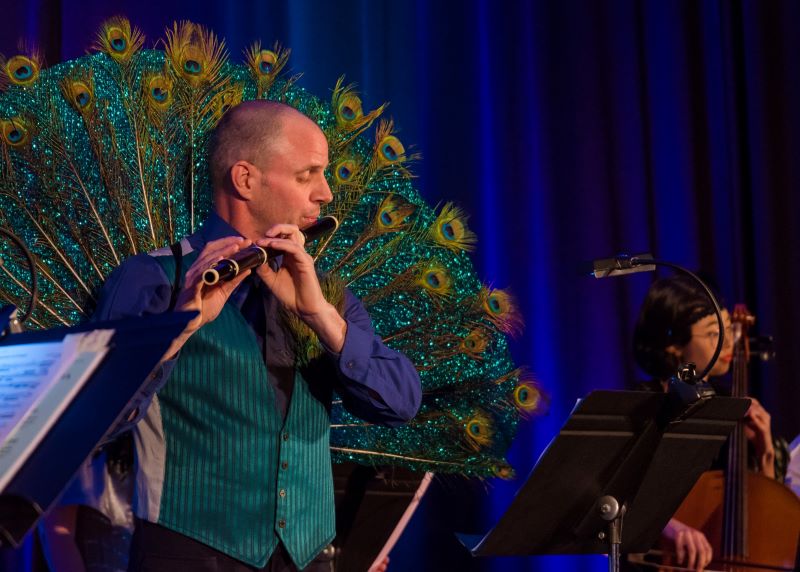What do birds, ancient music and children have in common? Rosalind Appleby and junior reviewer Isabel Greentree find out in this resplendent AWESOME Festival show.
Baroque splendour makes a fun adventure
30 September 2020
- Reading time • 6 minutesMusic
More like this
- Rewriting tradition with skill and charm
- Close encounter stirs the soul
- The great unknown
The Pigeon and the Albatross, Australian Baroque and AWESOME Festival ·
State Theatre Centre, 29 September ·
Review by Rosalind Appleby ·
At first glance you wouldn’t think that the establishment in Perth of a world class period instrument orchestra would be cause for celebration for children and their families. But in the the case of the dynamic Australian Baroque ensemble, whose show The Pigeon and the Albatross is featured at AWESOME Festival this week, there is plenty for kids to get excited about.
Perched on cushions on the floor, children sat enraptured by the exquisite costumes and sounds emanating from six musicians and a narrator as The Pigeon and the Albatross unfolded. The musicians were playing Baroque music on period (or replica) instruments and their costumes were a blend of 1920’s finery and bird plumage – a distinguished array of feathers, sequins, satin and tails. We spotted a galah, pigeon, cockatoo, peacock and kookaburra.
Narrator Stuart Halusz was dressed in immaculate black coattails and top hat, his crimson waistcoat and flaming red feathers on the crest of his hat completing his costume as a red-tailed black cockatoo. Halusz had the challenging job of narrating a story about an adventurous pigeon in quite sophisticated rhyming prose to a group of young children for 40 minutes. The story was interspersed and sometimes interrupted by excerpts of music by Vivaldi, Bach, Telemann and Biber.

On paper the combination of birds, ancient music and young children might seem a ridiculous proposition but Halusz and his flock of resplendent musicians brought elegance and panache to the tale. Halusz’ impressive skills in pacing, eye contact and body language kept drawing the attention of the children back to the story of a young pigeon who tries to rescue an albatross.
Meanwhile the children had a front row experience of the visceral energy of string players – the cascading scales in “Summer” from Vivaldi’s The Four Seasons were particularly effective at conveying the pigeon cowering under the attack of an eagle. My children were impressed by the resonant theorbo (a supersized plucked lute with 24 strings!) and flute player Andrew Skinner’s showy performance of a movement from Telemann’s Flute Concerto – watch out for his peacock tail!
The ensemble was led by violinist and artistic director Helen Kruger, recently returned from London, whose innovative approach to Baroque music is already turning heads. With a program ranging from “Cat Concerts” (their launch at Fringe World) to “Bach & Beer” (coming up in October) I have a hunch Perth audiences are going to lap up Australian Baroque!
The Pigeon and the Albatross, Australian Baroque and AWESOME Festival ·
State Theatre Centre, 29 September ·
Junior review by Isabel Greentree, age 10 ·
The Pigeon and the Albatross is a story about a long journey across the world to Antarctica. The story is told by a narrator and six musicians. There is no acting, but it is told in an exciting way with music as sound effects.
It was mostly string instruments and one flute. The instruments were in baroque style, which means that the violins had no chin rest or shoulder rest and the cello had no spike at the bottom and was supported by the player’s legs. The flute was more like a recorder played to the side. One musician had a theorbo, which is like a guitar with a lot of strings and some of them had a really low tone which acted as a bass for the music.
I liked the music because the musicians knew when to come in at the right time and played music that suited the story line. My favourite instruments were the violins and the cello because of the beautiful sounds they made. The musicians and the narrator wore costumes to look like the birds in the story. The narrator was funny because when the pigeon said he was too tired to go on, he walked in amongst where the children were sitting and lay down on some of the empty cushions. He also acted out some of the more exciting parts of the story to increase the dramatic tension.
It is a good story but since there are no actors, it is probably recommended for children over six years old.
The Pigeon and the Albatross continues until 2 October.
Pictured top: Australian Baroque’s combination of music, costume and storytelling transfixes children. Photo Richard Watson
Like what you're reading? Support Seesaw.






